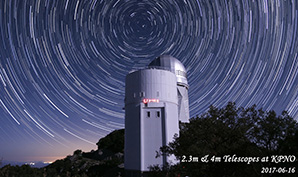Beijing-Arizona Sky Survey Completed

The Beijing-Arizona Sky Survey (BASS) completed its observations on the Bok Telescope on February 13, 2019, after surveying the sky for 375 nights over the last four years. The BASS survey is an ambitious wide-field multicolor survey of 5000 square degrees of the Northern Galactic Cap, using Steward Observatory's 2.3m Bok Telescope and its 90Prime imager at Kitt Peak. It is an international collaboration between the Chinese team led by NAOC and the US team led by Steward Observatory. The survey is led by Drs. Xu Zhou and Hu Zou at NAOC and Dr. Xiaohui Fan at UA.
The BASS survey is part of the DESI Legacy Imaging Surveys, which use three telescopes: the 4-meter Blanco Telescope in Chile (the DECam Legacy Survey, or DECaLS), the Mayall 4-meter telescope at Kitt Peak (the Mosaic z-band Legacy Survey, or MzLS), and Bok, to image about 14,000 square degrees of the sky to approximately 24 magnitude in 3 optical bands, to a depth of a factor of four deeper than the famous Sloan Digital Sky Survey over the same area. A key goal of these three surveys is to provide the input catalog for the target selection of the upcoming spectrographic survey, the Dark Energy Spectroscopic Instrument (DESI), which will commence on the Mayall Telescope on Kitt Peak later this year. With a new powerful 5000-fiber spectrograph on Mayall, the DESI project will measure the distances of about 30 million galaxies and quasars aiming at providing new measurements of the expansion history of the universe and the nature of dark energy. Arizona is an institutional partner of DESI.
In addition, the BASS survey, together with DECaLS and MzLS, will provide astronomers deep imaging data to pursue a wide range of astronomical researches ranging from nearby cool brown dwarfs to distant galaxies. UA astronomers led by Dr. Dennis Zaritsky have been using these data to search for diffuse dwarf galaxies, and a team led by Fan have utilized the surveys to uncover distant quasars. BASS is an open survey without proprietary period. Raw data are released immediately after they are obtained through the NOAO Science Archive and China Virtual Observatory. The final images and catalogs will be released through both the DESI Legacy Imaging Surveys data release 8 (DR8) this spring and the BASS DR3 this summer. (Text by Professor Xiaohui Fan.)
The Figure at the top of this article can be seen in all its glory HERE. It's a time lapse taken by one of the BASS observers. The second Figure is HERE. It's a map of the sky with BASS and other surveys outlined.

For Public
Public events include our Monday Night Lecture Series, world-reknowned Astronomy Camp and Mt Lemmon Sky Center.

For Students
A good place to start if you want to become an undergrad major or grad student, or need to find our schedule of classes.

For Scientists
Find telescopes and instruments, telescope time applications, staff and mountain contacts, and faculty and staff scientific interests.




